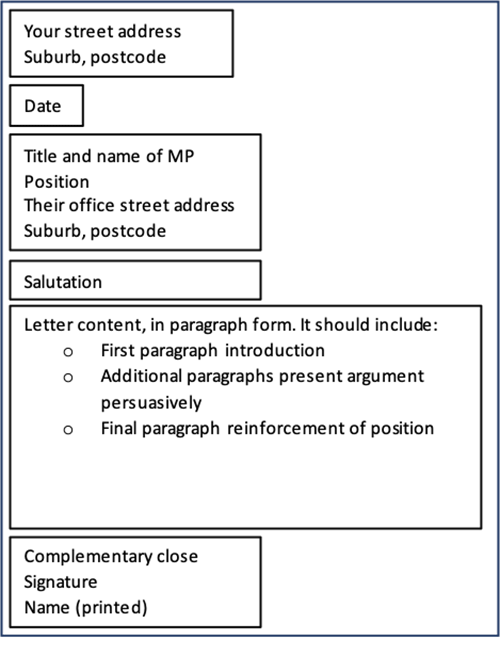Extended writing piece: Letter to a Member of Parliament
Our local Member of Parliament (MP) represents us in either the House of Representatives (Federal Government) or Legislative Assembly (Victorian State Government). Contacting Members of Parliament (MP) is one way for students to enact their citizenship and contribute to Australian democracy.
Writing a letter about an issue that is of concern is one of the most simple and effective ways to communicate with MPs. Other forms of communication include emails and phone calls.
Letters to MPs vary in purpose, including
- to inform
- to invite
- to persuade (or lobby)
- to complain
- to request
- to thank.
The example below demonstrates how the strategies listed above can be used to support students to write a letter to their MP about an issue that is of concern to them. The purpose of the letter is to persuade the MP to take action and vote in their favour on a topical issue in parliament.
Explicitly teaching text structure
As with all text types, letters have a unique text structure. Students need to understand the accepted ways in which letters are set out so that the letter they send is recognised as formal communication.
Providing students with a letter template, like the one below, will show them how to set out their letter, including where to write addresses and the date, what salutations to use, and how to sign off their letter.

Teachers can direct students to the following website on how to address (including salutation and complimentary close):
Building knowledge of the content and text structure
The written content of the letter will vary, depending on the issue and purpose of the letter. For a persuasive (or lobbying) letter, students should use a similar structure to an
analytical exposition. While formal language should be used, the letter is written in the first person as the student is communicating directly to the MP.
The suggested structure of the body of the letter is:
- the first paragraph introduces the writer and issue
- additional paragraphs present arguments persuasively
- final paragraph reinforces the position
(Access
Explicit teaching of analytical expositions for further details)
Introduction
In this section of the letter, students should introduce themselves and the issue about which they are writing. The introduction should be focused.
To support students to write focused introductions, teachers can:
- set word limits to encourage students to be succinct
- present model introductions (and letters) for students to analyse
- present extensive introductions that students must edit down.
Teaching students how to
modify base words may assist them to write more formally. Students should also be reminded to write in a respectful tone.
Additional and final paragraphs
As mentioned above, the purpose of the lobbying letter is to persuade the MP to vote in your favour on certain issues. As such, the remaining content of the letter should follow a similar structure to an
analytical exposition or
Structuring persuasive language analysis (writing) in the English section.)
Teachers may also support students to better articulate their opinion and provide justifications and elaborations by using the
Making a stand on an opinion line strategy.
Given the limited time MPs have to read letters from the public, the writing should again be succinct and focused. Students should be selective in their use of persuasive writing techniques to ensure their letter is both concise and persuasive.
One way to ensure students use a range of persuasive language techniques is to have them highlight each technique they use in a different colour. They can then more easily see which techniques they have used and reflect on whether the chosen technique is the best choice.
For example, repetition is a useful persuasive technique but may be problematic in letters to MPs given the letters should be focused. Selecting other techniques, such as appeals to authority, personal anecdotes or inclusive language, may be more appropriate for this text type.
It is also important to acknowledge any work that the MP has done in the area about which you are writing. Students may then ask the MP to take additional action to address the identified issue.
Note: There are other resources available that support students to write letters to MPs, many of which have been developed by advocacy groups, including:
Learning sequence
The
learning sequence for Levels 9 and 10 in Civics and Citizenship, demonstrates how literacy teaching strategies can be used in a sequence.
A
learning sequence tool is also available to assist in the planning of Civics Citizenship and Literacy across a series of lessons.